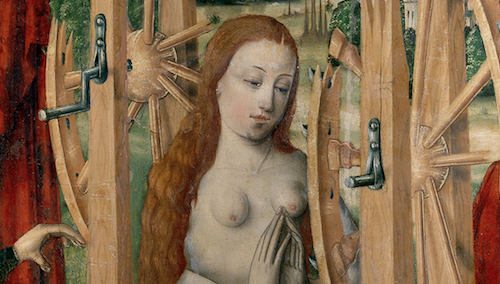User group: Vanessa Antunes
https://www.museodelprado.es/en
Venue: Prado (Madrid, ES)
Background to the project
To review technical documentation of paintings by Fernando Gallego y oficina at the Prado related to the former altarpiece of Goa Cathedral assigned to the Portuguese painter Garcia Fernandes.
Questions addressed by access
The ARCHLAB visit to the laboratories of analysis and documentation centre at Museo del Prado made possible a better understanding of technical practices from selected paintings by Fernando Gallego and his workshop. The aim was to identify technical aspects of the artist’s drawing and painting practices, such as the composition of the ground and priming layers, the technique of paint applications and pigments used, the structure of the support and the degradation state of the paintings under study.
Main objectives of the project proposal
Three works were previously selected : Martirio de Santa Catalina assigned to the circle of Fernando Gallego, 15th century, in Museo del Prado collection (inv. P03039), Madrid. This last work was compared to Portuguese production outside the mainland and to evaluate its influence on the local artistic production, in particular by stylistic and material comparison of the remaining altarpiece of the Goa Cathedral .Other paintings were compared to these last works in order to study the underdrawing execution, such as La Virgen anunciada (inv. P08024) and San Gabriel (inv. P08025), both incomplete paintings from the end of the 15th centuries of anonym authorship.
Main achievements of the ARCHLAB visit
The ARCHLAB visit offered close assessment of the paintings in the Gallery and in the warehouse being possible to confirm the presence of incised architectural drawing in the painting Cristo bendiciendo (P002647) and the absence of gold leaf in this painting and in painting La Piedad (P002998).It was confirmed the presence of gold applied by brush in the halos of both paintings.
High resolution digital images including IRR and surface information and X-Ray radiographs of the Prado paintings were examined. Samples from the paintings were re-examined using light microscopy and SEM-EDX. The analysis addressed the question of the composition of the ground layers as calcium sulphate(gypsum and anhydrite).
Cross sections study simultaneously with information from technical images of the paintings under study demonstrated the pine supports structure with the presence of vertical canvas in the joints under the ground layers, typical characteristic of Spanish painting of the 15th/16th centuries. Also the method of planning the composition was possible to study. A first drawing by dry technique with charcoal, a second reinforcement with ink and the final scattering with the same ink. This is the technique also confirmed in a Portuguese treatise from the first half of the 17th century: the painter “pictured the image with charcoal, and then with ink from the ink bottle he debuted it, and scattered with the same ink” (Monteiro e Cruz 2010).It was possible to confirm also a thin dry technique(graphite?) in the contour of the figures of the unfinished paintings La Virgen anunciada (inv. P08024) and San Gabriel (inv. P08025).These figures could possibly have been contour modelled from a previous drawing or cut out card.
The analysis of the ground layers highlighted the inclusion of both calcium sulphate anhydrite,the major constitant of “gesso grosso” under gypsum layer “gesso mate”. A similar colour palette was used for the paintings under study from Gallego and his workshop and Fernandes. Although were seen significant differences between both painters. Gallego painter on pine support and Garcia Fernandes painter on Baltic oak support. Garcia Fernandes does not include gold leaf in his works and Gallego workshop in the painting Martirio de Santa Catalina (inv. P03039) use gold leaf to decorate the mantle of a noble figure. The analysis of IRR underdrawing and the observation by naked eye of the deterioration of this painting allowed understanding the process of drawing and applying the gold leaf in the painting: The painter drawn the composition in black charcoal with four levels of drawing. A first dry charcoal drawing, a second reinforcement in ink, making the contour of the figures and a third level of scattering in ink (with parallel traces for light shadows and crossed traces for darker areas of shadowing); a fourth contour incise drawing was found only in the reservation for the gold leaf existence in order to excavate the ground layer to apply the bol clay before gilding. This excavation of the ground layer is visible nowadays in the armor of the soldier that was probably gilded in its origin. The reservation and excavation were made in this case in order to maintain the same flatness in the superficial layer of the painting after bol clay was applied.IRR also made possible to identify a word written in the underdrawing of this painting. This word was a possible identification of the city to be painted in the background ( YEVA NG(Yerusalen?)).A future IRR may confirm this aspect.

